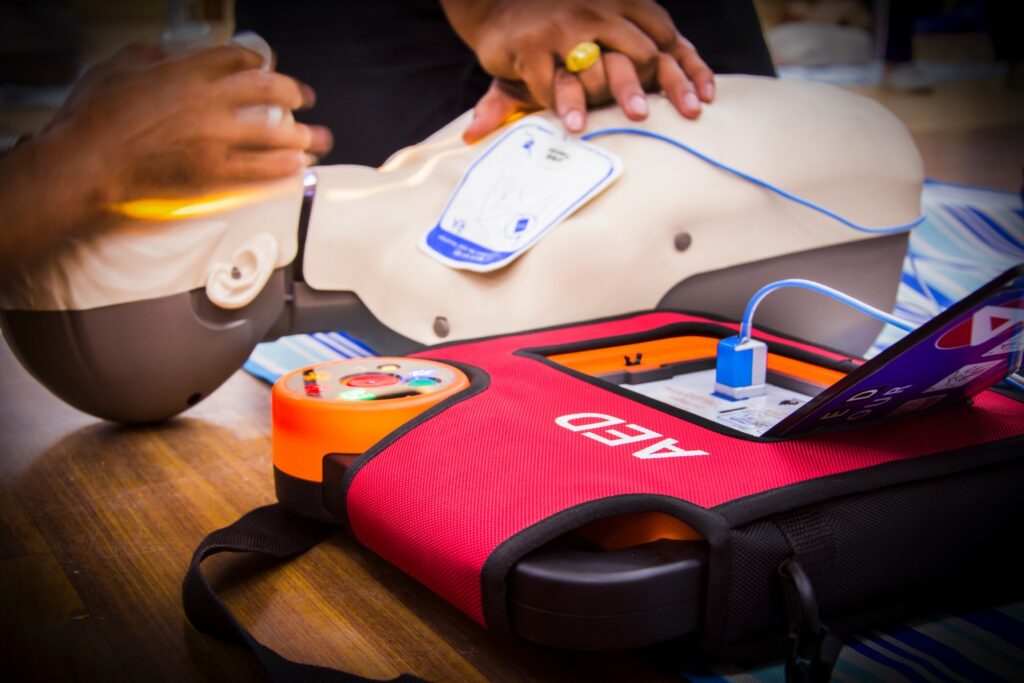CPR Training: Insights from Our Office Training
Last week, our office had an in-office CPR (Cardiopulmonary Resuscitation) training session, a crucial skill that could save lives. I was a lifeguard in my youth and taught CPR long ago. Like in many subjects I learned in school, the concepts have evolved.
While many of us might have associated CPR with medical professionals and lifeguards, we quickly learned that anyone, even those in the corporate world, can play an integral role in emergencies. Here’s what we learned, why it matters, and why every office should consider such training.
1. The Basics of CPR
CPR is a lifesaving technique that one can use if someone is not breathing properly or if their heart has stopped. Our instructor, Daniel Sheffield, emphasized that during a cardiac arrest, every second counts. Brain death can start to occur in just 4 to 6 minutes after cardiac arrest. With proper CPR training, one can manually preserve intact brain function until further measures are taken to restore spontaneous blood circulation and breathing in a person.
2. Recognizing the Signs
The first step before performing CPR is to recognize the signs of a cardiac arrest. These include unresponsiveness, no breathing or only gasping, and no pulse. Our training emphasized the importance of quickly calling 911 or urging someone else to before starting CPR.
3. The Technique
Our hands-on CPR training practice sessions highlighted the two main components of CPR: chest compressions and rescue breaths. We were taught the proper technique, pace, and depth for compressions. The recommended rate is about 100-120 compressions per minute, roughly to the beat of the song “Stayin’ Alive” by the Bee Gees. Proper hand placement and body posture were also emphasized to ensure effectiveness and reduce fatigue.
While the rescue breaths component can be vital, we also learned about hands-on CPR, where one focuses solely on chest compressions. For untrained individuals or those unsure about giving breaths, hands-on CPR can still be incredibly effective.
4. Automated External Defibrillators (AEDs)
In addition to CPR, we were introduced to AEDs. These portable devices can check the heart’s rhythm and send an electric shock to the heart to try and restore a normal rhythm during cardiac arrests. The highlight of this section was the practical hands-on experience, where we learned how to operate an AED, including placing the pads, following voice prompts, and ensuring safety. Getting one is now on our shopping list.
5. The Importance in the Office Setting
You might wonder why CPR training is relevant in an office? The truth is that emergencies are unpredictable. They can happen anytime, anywhere—during a meeting, at your desk, or in the break room. As we spend a significant amount of time at our workplace, having staff trained in CPR increases the chances of survival if someone experiences a cardiac arrest at work.
Moreover, the skills learned in CPR training aren’t restricted to the office. They can be applied at home, during travels, or in public places. It empowers individuals to be potential lifesavers in critical situations.
On Wednesday after the training, I never felt safer in my office. They may wear off, and we will need refreshing. It does fit in well, though, with a team whose primary focus is to plan and be prepared for handling life’s challenging circumstances.
6. Fostering a Culture of Preparedness
Beyond the technical skills, the CPR training session instilled a sense of responsibility and preparedness. It fostered a culture of looking out for one another, of being equipped to assist not just in work-related matters but in life-threatening situations as well.
Don’t be intimidated. If you have a chance to learn, it can be child’s play.
In Conclusion
Our office’s CPR training was an eye-opening experience. It underscored the importance of being proactive, not just in our professional roles but as members of a broader community. As we returned to our desks, we did so with a heightened sense of camaraderie and the reassuring knowledge that many of us are now equipped with a vital, potentially lifesaving skill.
For offices and corporate environments everywhere, investing in CPR training isn’t just a tick in the HR checklist—it’s a commitment to the well-being and safety of every individual. And in the grand scheme, that’s an investment well worth making.
It also may be comforting to know that we can not only help you when you are dead but may even help postpone that some.


